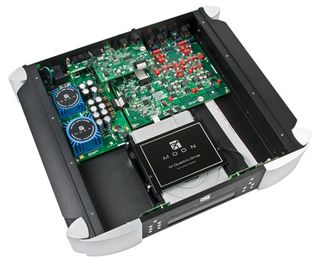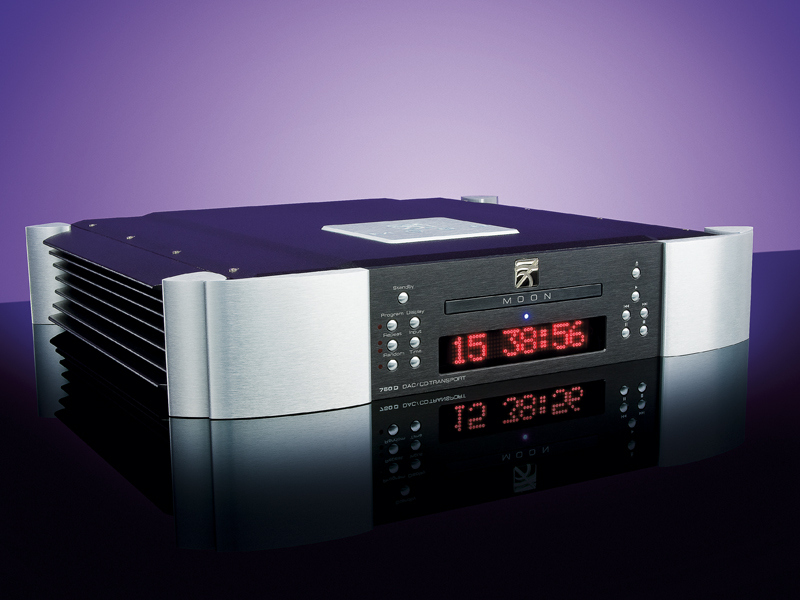TechRadar Verdict
Few CD players can deliver as much information off disc as the 750D and for those who appreciate great imaging and fine detail, it's a genuine bargain. It's also amazingly calm and measured in its performance
Pros
- +
Uncannily resolute player
- +
Good range of digital inputs
- +
High build quality
- +
Holds its own against the competition
- +
Confident with a wide range of music sources
Cons
- -
Doesn't like glass equipment racks
- -
The remote handset is not quite as nice as the player itself
Why you can trust TechRadar
Simaudio claims that the Moon 750D contains not only its most advanced digital-to-analogue converter yet, but that it's the first true 32-bit fully asynchronous digital audio player to reach the market.
It also describes this substantial machine as a DAC plus a transport, which is odd given that in most respects it seems to be an integrated player. It's the plethora of inputs and the fact that it can accept high-res digital signals that explains this approach.
The 750D is a superbly built player from a company that has extremely good form, so expectations are high for this new midrange model.
DAC or player?
Not many companies claim 32-bit conversion for their DACs. In fact, we could only find one other, namely Cary, whose Exciter DAC uses an AKM chipset.
In practice, there is no such thing as a 32-bit DAC, because all contemporary DACs are low-bit types that oversample at a high enough rate to give what is usually 24-bit resolution, but there's no reason why you can't run them faster.
MSB's Platinum DAC operates at 80-bits in its DSP, but the company only claims a bit depth of 26-bits and that's because it builds its own converters.
Ultimately, 'bits' are misleading because however many the DAC claims to use, any advantages are going to be lost in noise, so dynamic range is a more useful description of a DACs capabilities.
Moon claims the SABRE DAC, is greater than 130dB, while the best result that can be achieved with a good 24-bit DAC is just 144dB. Moon's description of the 750D as a DAC with a transport rather than a regular integrated player is backed up by the unusual range of digital inputs provided on its back panel.

As well as RCA phono and Toslink for electrical and optical S/PDIF inputs, it can accept AES/EBU inputs via XLR and has a USB socket. This should mean that if you have high-res music files on your laptop and the software to play them back, you can do so via this player.
I discovered, however, when talking to Moon's Dominique Poupart, that as it stands the USB input is limited to 16/44 operation. The other inputs will accept sampling rates up to 24-bit/192khz, so all you have to do is find a source that can output such a bitstream.
According to Moon, the SABRE DAC/filter achieves 'unprecedented jitter immunity and low-level linearity'. I don't know about the measurements, but it certainly sounds uncommonly clean, which would suggest that there is substance to this claim.
The transport side of the 750D is isolated by Moon's M-Quattro suspension system. This is a gel-based mounting that dampens resonances produced by the transport mechanism and the disc's rotation. The latter is useful because the majority of CDs aren't centred and can create quite a lot of extraneous energy when spun at a CD's high revs.
Analogue output connections are high quality examples of RCA phono sockets for single-ended and XLRs for balanced, while digital outputs come in electrical coaxial and AES/EBU forms.
Unusually, the 750D has two XLRs marked for external power supply, presumably something along the lines of the Cyrus PSX-R, which the manual says will be made available for this player in future.
Heavy metal
As you have a right to expect at this price, the Moon 750D is extremely well put together and suitably hefty. Its chassis is made up of aluminium slabs that have been precision machined to fit together perfectly.
The triangular section corner posts have threaded holes in their bottoms and Moon supplies four conical spikes to screw in. It also supplies little dimpled discs to put under the spikes to stop them from damaging a wooden surface.

The drawer is particularly nicely machined from a slim aluminium section and it opens with the sort of smoothness that you only get with high-end players – there are no clunks or whirring of motors here.
The front buttons are logically laid out for the most common functions, but the inscriptions are a little on the small side for more in-depth use. Most are replicated on the remote handset, which is another slab of alloy – this time powder coated, rather than machined.
This is intuitive to use and has volume and source functions that operate other Rc-5 protocol components. It also has an eject button, but none for track entry.
In its price range, the Moon 750D has some serious competition to contend with, such as the Wadia 381i, which also has plenty of digital inputs, albeit not USB, and can seemingly everything about itself when the music is fairly simple, yet when things get dense there is no sense of blurring or rush – everything is presented in a coherent and precise fashion with a degree of effortlessness that is rare even at silly price points.
It has something of the character of Boulder's 1021 in this respect, but manages to bring a little bit more of the soul of the music to the party. The Boulder is extraordinarily quiet and detailed, but somehow lacking in heart, while the Moon is a little warmer and less digital.
While not quite as musical as the Rega Isis, which is something of a master of this particular art, the 750 has a decent grasp of timing as it does with all the detail on the disc, or so it seems. Sometimes the sheer quantity of information can distract you from the musical message, but not in a bad way – it's more a case of hearing elements that had previously been masked.
Steely Dan's Boston Rag has a guitar solo on it, for instance, that has not really made much of an impression in the past, but here it becomes quite engrossing thanks to the new layers of tonal and textural detail that the Moon reveals. It also images with great precision.
Some discs like the aforementioned 'Dan' number are pretty constrained, but more up to date tracks, such as Antonio Forcione's Tears of Joy, produce a soundstage that's pushing at the walls and ceiling and coming well into the room. The Moon has plenty of dynamic range, albeit not as much as the best in class.
It doesn't get noisy around the edges in the way that many dynamic players do. You can keep turning the wick up, safe in the knowledge that digital edginess is not going to turn up. Detail With a spectacular recording it can create a full scale, 3D image that beggars belief and it can show you the precise nature of all the sounds on the disc.
Resolution revolution
This is unquestionably a superbly built and remarkably revealing CD player, or even DAC and transport in one box, and it allowed me to properly hear the constituent parts of well worn discs that have rarely been apparent in over 20 years of reviewing.
There are more musically engaging players, but you trade quite a bit of resolution for that elusive quality. If you enjoy true high-fidelity qualities this is a hard player to beat.
Add to this, its broad range of digital inputs and fabulous build quality and you have a star player even at its elevated price point.

